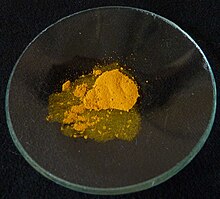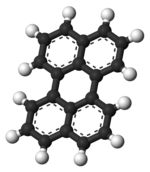Perylene
| |||

| |||
| Names | |||
|---|---|---|---|
| Preferred IUPAC name
Perylene[2] | |||
| Other names
peri-Dinaphthalene; Perilene; Dibenz[de,kl]anthracene
| |||
| Identifiers | |||
3D model (JSmol)
|
|||
| 1911335 | |||
| ChEBI | |||
| ChEMBL | |||
| ChemSpider | |||
| ECHA InfoCard | 100.005.365 | ||
| EC Number |
| ||
| 104944 | |||
| KEGG | |||
PubChemCID
|
|||
| RTECS number |
| ||
| UNII | |||
CompTox Dashboard(EPA)
|
|||
| |||
| |||
| Properties | |||
| C20H12 | |||
| Molar mass | 252.316g·mol−1 | ||
| Appearance | Brown solid | ||
| Melting point | 276 to 279 °C (529 to 534 °F; 549 to 552 K) | ||
| -166.8·10−6cm3/mol | |||
Except where otherwise noted, data are given for materials in theirstandard state(at 25 °C [77 °F], 100 kPa).
| |||
Peryleneorperileneis apolycyclic aromatic hydrocarbonwith thechemical formulaC20H12,occurring as a brown solid. It or its derivatives may becarcinogenic,and it is considered to be a hazardouspollutant.Incell membranecytochemistry,perylene is used as afluorescentlipid probe.It is the parent compound of a class ofrylene dyes.
Reactions[edit]
Like other polycyclic aromatic compounds, perylene is reduced by alkali metals to give a deeply colored radical anion and a dianion. Thediglymesolvates of these salts have been characterized byX-ray crystallography.[3]
Emission[edit]
Perylene displays bluefluorescence.It is used as a blue-emitting dopant material inOLEDs,either pure or substituted. Perylene can be also used as an organicphotoconductor.It has an absorption maximum at 434 nm, and as with all polycyclic aromatic compounds, low water solubility (1.2 x 10−5mmol/L). Perylene has amolar absorptivityof 38,500 M−1cm−1at 435.7 nm.
-
Perylene dissolved indichloromethaneexposed toLong Wave UV radiation
-
Perylene dissolved in dichloromethane exposed toShort Wave UV radiation
Structure[edit]

The perylenemoleculeconsists of twonaphthalenemolecules connected by a carbon-carbon bond at the 1 and 8 positions on both molecules. All of thecarbonatoms in perylene aresp2hybridized. The structure of perylene has been extensively studied byX-ray crystallography.[4]
Biology[edit]
Naturally occurring perylenequinoneshave been identified inlichensLaurerasanguinariaMalme andGraphis haematitesFée.[5]
References[edit]
- ^PeryleneatSigma-Aldrich
- ^International Union of Pure and Applied Chemistry(2014).Nomenclature of Organic Chemistry: IUPAC Recommendations and Preferred Names 2013.The Royal Society of Chemistry.p. 206.doi:10.1039/9781849733069.ISBN978-0-85404-182-4.
- ^Näther, Christian; Bock, Hans; Havlas, Zdenek; Hauck, Tim (1998). "Solvent-Shared and Solvent-Separated Ion Multiples of Perylene Radical Anions and Dianions: An Exemplary Case of Alkali Metal Cation Solvation".Organometallics.17(21): 4707–4715.doi:10.1021/om970610g.
- ^Donaldson, D. M.; Robertson, J. M.; White, J. G. (1953). "The crystal and molecular structure of perylene".Proceedings of the Royal Society A.220(1142): 311–321.Bibcode:1953RSPSA.220..311D.doi:10.1098/rspa.1953.0189.JSTOR99329.S2CID97262226.
- ^Annick Mathey, Wim Van Roy, Luc Van Vaeck, Gert Eckhardt, Wolfgang Steglich (1994). "In situ analysis of a new perylene quinone in lichens by Fourier-transform laser microprobe mass spectrometry with external source".Rapid Communications in Mass Spectrometry.8(1): 46–52.Bibcode:1994RCMS....8...46M.doi:10.1002/rcm.1290080109.
{{cite journal}}:CS1 maint: multiple names: authors list (link)




